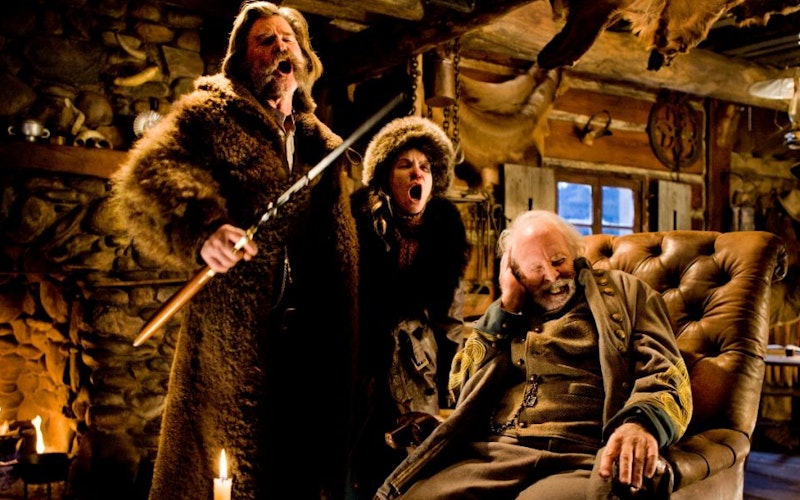
Movies
The Hateful Eight’s Missing Man of Sorrows
The Hateful Eight is at once one of Quentin Tarantino’s most formally accomplished pictures and his most thematically thin. It’s a gloriously filmed, cleverly structured, 70mm extravaganza, but beyond an ample portion of hate and violence, Tarantino is unable to fill the wide screen with many substantive ideas.
Some have argued otherwise, saying that the movie — which gleefully watches a random collection of snowbound, Reconstruction-era killers go at each other’s throats — has much to say about the sins of America’s past, and how they still resonate in the present. More persuasive to me is the suggestion, made by other supporters of the film, that The Hateful Eight is simply an audacious provocation intended to do little more than discomfit its audience. From its choice of comic beats (gunshots and racial epithets often serve as punch lines) to the way the lip-smacking camera lingers on acts of extreme violence, the movie seems to have concluded that since everyone onscreen is reprehensible and deserves to die, we might as well have fun watching them get their comeuppance.
Yet it’s the emphasis on “fun,” not necessarily the hate and violence themselves, that’s bothersome. After all, recognizing the groaning of creation and the fallibility of man is downright biblical. Scripture acknowledges the realities of evil, and movies—often extreme ones—can help us with our corresponding confrontation. It’s in the response that things get complicated. The giddy nihilism that defines The Hateful Eight and the feverish retribution with which it concludes don’t strike me as particularly sophisticated—as art, entertainment, or theology. Surely something more substantial can be said about the awfulness in the world.
A great irony of The Hateful Eight is that it opens with an image suggesting a whole host of more nuanced notions about how to respond to evil. The camera offers a tight close-up of a statue, then pulls back ever so slowly to reveal that it’s a statue of Christ on the cross, bearing the additional burden of a good foot of snow. Ideas like sorrow, lament, grace, and mercy may come to mind with this image, but Tarantino uses the crucifix to grimly bookend the film in a far more simplistic way. After starting with this symbol of execution, the movie ends with a matching shot of one of its more vile characters being lynched, all while the executioners cackle away.
Using the cross in this way blithely breezes past Isaiah 53, which points to Christ as a “man of sorrows.” God’s response to the world’s awfulness, thank goodness, was not a juvenile one, akin to what we see in The Hateful Eight. He didn’t sit back and giggle as we tore each other apart. Nor did he hand deliver our death sentence. Rather, he mourned our rejection of him, he pursued us anyway, and he took on our sorrows as his own.
The Hateful Eight uses its 70mm canvas to masterfully display the depravity of humankind, yet in the end its moral universe is small. Like preschoolers squabbling in a sandbox, its characters only know how to hit back. I’m not asking Tarantino to encompass the scope of the Gospel in a film that is clearly not interested in redemption, yet even previous Tarantino films had enough moral imagination to make room for something like sorrow. (Think of Harvey Keitel cradling a dying Tim Roth in Reservoir Dogs or the clanging shackles of Django Unchained.) The Hateful Eight is too true to its title. Despite that crucifix, it has no concept of the loving One.
Topics: Movies, Culture At Large, Arts & Leisure